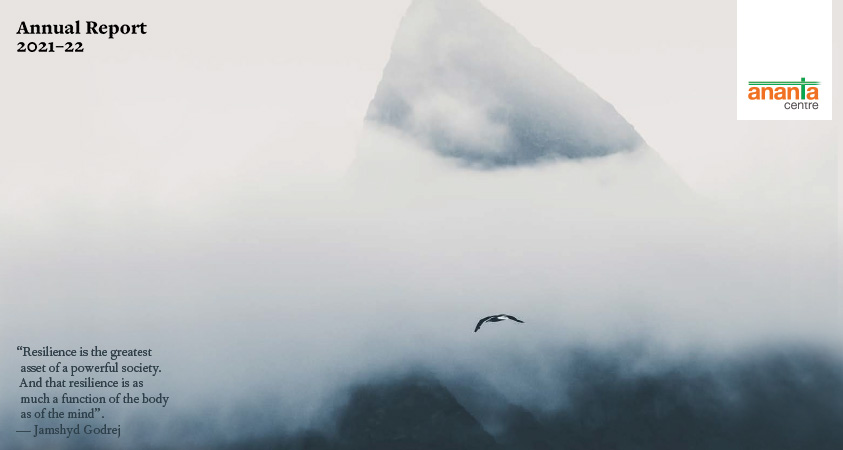Report on economy exudes confidence and optimism
The Union finance ministry’s latest half-yearly report on the state of the Indian economy in 2023-24 presents a picture of confidence and optimism. The report notes that the Indian economy should comfortably achieve an annual growth rate of 6.5 per cent in 2023-24. There could be risks to growth and stability, but these emanate mainly from outside the country, according to the report. On the domestic front, it notes that the better-than-expected growth in the second quarter of 2023-24 at 7.6 per cent, which has raised the growth rate for the first half of the current year to 7.7 per cent, has already improved the overall growth prospects. Various institutions and agencies have begun upgrading their growth outlook for India. The most significant of them is the one from the Reserve Bank of India, which has raised India’s growth rate for 2023-24 to 7 per cent, up from the earlier 6.5 per cent. Similarly, the Asian Development Bank has raised it from 6.3 per cent to 6.7 per cent, while many other rating agencies and banks have raised it from the earlier projection of 6.2-6.4 per cent to 6.8-7 per cent. What has made the finance ministry more optimistic on the growth front is the robust activity level captured by high-frequency indicators for October and November 2023. The Purchasing Manager’s Index for both manufacturing and services is in expansion mode for October and November. The October 2023 print for industrial growth and core industries growth at 11.7 per cent and 12.1 per cent, respectively, has reiterated sustained growth in manufacturing. The services sector prospects look bright, helped by a noticeable improvement in the hospitality industry with a sharp increase in leisure as well as business travels and social events. Consumption demand too looks to be in good shape with urban demand conditions showing resilience as evident from higher growth in automobile sales, fuel consumption and transactions through the Unified Payment Interface or UPI. Even rural demand is showing a pick-up, the finance ministry notes, as the growth in the sales of two and three-wheelers have seen robust growth.
Mixed outlook on inflation continues to pose challenges
The overall outlook for inflation, according to the government, is indicative of a stable downward movement in core inflation and continuing deflation in fuel prices and a declining trend in headline inflation. There is, however, some concern over temporary disruptions from food prices. For the full year of 2023-24, the Reserve Bank of India (RBI) has projected an average retail inflation rate of 5.4 per cent, which would though be higher than the 4 per cent target, set by the government to be met by the Monetary Policy Committee of the RBI. The retail inflation rate for November 2023 was estimated at 5.5 per cent, which represented an increase over 4.87 per cent in the previous month. As the finance ministry note had indicated, retail food inflation in November rose to a three-month high of 8.7 per cent, up from 6.61 per cent in the previous month, following vegetable inflation rising sharply to 17.7 per cent. Core inflation, which does not include volatile food and fuel prices, was close to 4 per cent in November, as fuel prices contracted by 0.77 per cent – the third consecutive month of their decline. Wholesale prices, however, maintained a different trajectory. For November 2023, inflation, based on the movement of the Wholesale Price Index or WPI, was estimated at 0.26 per cent. This was a significant development as WPI-based inflation in November broke the seven-month record of a decline in prices and it represented an eight-month high. In October 2023, WPI was in contraction mode of 9.52 per cent. The return of WPI-based inflation to positive territory was driven by an erosion in the high-base effect and an increase in prices of food articles, minerals, machinery, equipment, computers, electronics, optical products, motor vehicles and transport equipment. The sharp variance in the trajectory of retail inflation and that of wholesale inflation has obvious implications for managing prices.
External sector resilient with falling current account deficit
India’s external sector has performed well, despite the challenges of a slowing global trade and rising geopolitical tensions. Overall exports (including both merchandise and services) in November 2023 were estimated at $62.58 billion, marginally up from $61.82 billion in the same month of 2022. This was only the third month of 2023-24, when total exports of merchandise and services were higher than those in the corresponding months of 2022-23. Barring April, October and November, all other months of 2023-24 saw total exports lag those of the corresponding months of 2022-23. Cumulatively, therefore, overall exports during April-November 2023 were $499.46 billion, 1.4 per cent lower than the same period of 2022. However, since, total imports in April-November 2023 fell by a higher rate of over 7.5 per cent at $560.90 billion, total trade deficit during this period fell to $61.44 billion, compared to $100 billion in the same months of 2022. Not surprisingly, India’s current account deficit fell to 1 per cent of gross domestic product (GDP) at $8.3 billion by the end of the September quarter of 2023. The current account deficit for the first half of the year was 2.9 per cent of GDP. The Indian rupee during the most part of 2023 remained relatively stable against the US dollar and other prominent currencies, with the country’s foreign exchange reserves at $620 billion at the end of December 22, 2023, which was a 21-month high level. During 2023, the Reserve Bank of India managed to add about $58 billion to the reserves. Foreign portfolio investment flows began reviving from November and inflows of foreign direct investment too recovered in October, although in the early months of 2023-24 they had declined. On the debt front, the International Monetary Fund has flagged risks for India, noting that the country’s general government debt could exceed 100 per cent of gross domestic product in the medium term, an assessment that the government has disagreed with.
Centre set to meet its deficit target with higher tax revenues
The Union Government’s finances continued to remain in good shape. By the end of the first eight months of 2023-24, the Centre’s fiscal deficit accounted for just about 51 per cent of full-year’s target, much lower than the 59 per cent that had been reached at the end of November last year. In absolute terms, the Centre’s fiscal deficit at the end of November 2023 was Rs 9.1 lakh crore, compared to Rs 9.8 lakh crore at the end of November 2022. This was largely due to robust growth in net tax collections in these eight months – rising by 17 per cent to Rs 14.36 lakh crore. The Budget had set a target of growing the Centre’s net tax collections by about 11 per cent at the end of the year to Rs 23.3 lakh crore. While non-tax revenues too have done well, thanks to a higher transfer of surplus from the Reserve Bank of India, the Centre’s revenue expenditure growth in April-November 2023 is still higher at 3.5 per cent, compared to the annual Budget target of 1.4 per cent. But the growth has been decelerating in the last few months and is a sign that the government is reining in its revenue expenditure. Capital expenditure, which is targeted to grow by 36 per cent to Rs 10 lakh crore in 2023-24, has begun to slow down a bit in the last couple of months. At Rs 5.86 lakh crore at the end of November 2023, the Centre’s capital spending has grown by 31 per cent. The only big shortfall in the government’s receipts is in disinvestment proceeds, which by the end of November 2023 were estimated at Rs 8,860 crore, down 69 per cent over the same period of 2022. The disinvestment target for the full year of 2023-24 was kept at Rs 61,000 crore and this will be yet another occasion in the last few years when the government would fall short of its disinvestment targets by a significant margin. This reflects the government’s lack of strategic focus on implementing its disinvestment and privatisation plan.
State finances get better, improving their fiscal health
The finances of the state governments have been getting better. Most states (23 states accounting for over 93 per cent of all the states’ total budgets) in the first half of 2023-24 saw their own tax revenues rise by an average rate of about 15 per cent. This growth was supplemented by a 21 per cent rise in the tax transferred to them by the Union government. More encouraging was the 53 per cent increase in their capital expenditure during the April-September period of 2023-24. This improvement in state finances began earlier in 2022-23, for which period a report by the Reserve Bank of India has brought out encouraging numbers. The combined gross fiscal deficit for all the states in 2022-23 was reined in at 2.8 per cent of the gross domestic product or GDP. This was below what was projected by these states in their budget estimates. This improvement was achieved through a containment in their revenue expenditure and after providing for higher capital outlays. The states are expected to report a fiscal deficit of 3.1 per cent of GDP in 2023-24, but expectations of higher tax revenues should help them meet this target, which in any case is lower than the target of 3.5 per cent of GDP set by the Centre.
Financial sector health improves, but concerns remain
India’s financial sector seems to have hit a purple patch as far as its financial health is concerned. By the end of September 2023, the gross non-performing assets (or sticky loans) of Indian banks fell further to 3.2 per cent of their total advances – a 10-year low. The Reserve Bank of India’s latest report (Trend & Progress Report for 2022-23) noted that lower slippages helped improve asset quality across all bank groups, with the scheduled commercial banks’ ratio of gross non-performing assets to total advances dropping to a 10-year low. “Higher lending rates and lower provisioning requirements helped improve the profitability of banks and shored up their capital positions,” it added. However, the report also noted that with rising deposit rates catching up with that in lending rates, the profitability of banks could moderate in the coming days. The report also noted that banks needed to strengthen their balance sheet further, improve governance standards and remain watchful about the rise in unsecured loans. The report drew attention of policy makers to another area. Even as banks remained well-capitalised, they needed to evaluate their exposure to non-banking financial companies (NBFCs) and the exposure of individual NBFCS to multiple banks. NBFCs have been urged to broad base their funding sources and reduce their overdependence on bank funding. Another report of the Reserve Bank of India (Financial Stability Report) pointed out that with the net non-performing assets declining to a record low of 0.8 per cent of gross advances and a capital adequacy ratio of 16.6 per cent, the health of the banking system was strong enough to absorb macroeconomic shocks even without any further capital infusion by shareholders. There were two areas of concern. Bad loans from the farm sector remained high at 7 per cent and the overall asset quality level in retail loans had seen some impairment in credit-card receivables.
A new law for telecommunications exempts OTTs
A new law ushering in a major sector reform got Parliament’s green signal on December 21, when it passed the Telecommunications Bill, 2023. The new law defined telecommunications services as “any service for telecommunications”, which was different from earlier drafts of the law. Earlier drafts had extended the definition to include over-the-top (OTT) platforms like WhatsApp and Skype, among a host of specialized communication services. Now, the new law has let OTTs off the hook and also empowered the government to take over any telecom service or network in case of public emergency. It also allows the Union government to intercept any message between individuals and allows a private-sector person to be chosen as the head of the telecom regulatory body.























